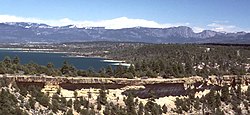San Juan-Chama Project

Heron Lake, the main storage reservoir of the San Juan-Chama Project
|
|
| General statistics | |
|---|---|
| Begun | 1951 |
| Completed | 1976 |
| Dams and reservoirs |
Heron Nambe Falls Blanco (diversion) Oso (diversion) Little Oso (diversion) |
| Operations | |
| Storage capacity | 403,343 acre·ft (0.497516 km3) |
| Annual water yield | 110,000 acre·ft (0.14 km3) |
| Land irrigated | 92,479 acres (37,425 ha) |
The San Juan-Chama Project is a U.S. Bureau of Reclamation interbasin water transfer project located in the states of New Mexico and Colorado in the United States. The project consists of a series of tunnels and diversions that take water from the drainage basin of the San Juan River – a tributary of the Colorado River – to supplement water resources in the Rio Grande watershed. The project furnishes water for irrigation and municipal water supply to cities along the Rio Grande including Albuquerque and Santa Fe.
Most major agricultural and urban areas in New Mexico today lie along the narrow corridor of the Rio Grande as it cuts across the center of this predominantly desert state. Spanish settlers arrived in the area in the late 1500s, followed by Mexican and American settlers in the 18th and 19th centuries, building large irrigation systems and diversion dams to allow agricultural production in the arid region. In the early 1920s, water supply in the Rio Grande basin was already severely stressed, and studies were conducted as to the feasibility of procuring additional water by transbasin diversion from tributaries of the San Juan River.
The 1933-1934 Bunger Survey studied potential locations for diversions and storage reservoirs, and in 1939, the Rio Grande Compact was signed, dividing Rio Grande waters between Colorado, New Mexico and Texas including allocations from a potential future diversion from the San Juan basin. When the Upper Colorado River Basin Compact was established in 1948, it also included provisions for the tentative diversion project under its water allotment to New Mexico. In the 1950s, post-World War II population growth in central New Mexico put even larger strains on the Rio Grande's water, and the need for a transbasin water project rose because water supplies in the area quickly became overallocated.
...
Wikipedia
